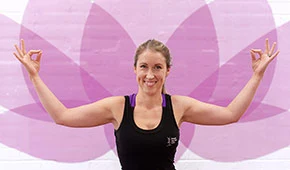
How Yoga works as a complementary therapy for patients with breast cancer
Quick links:
– What is breast cancer
– Current cancer treatments
– Yoga as a complementary therapy
– The benefits of Yoga as a complementary therapy
Breast cancer is the second most common cancer in women worldwide, representing 12% of all new cancer cases and 25% of all cancers in women. It is the most frequently diagnosed cancer among women in 140 of 184 countries worldwide.
Yoga can be used as a complementary therapy to help strengthen the body and reduce stress. For many cancer patients and survivors, Yoga has greatly improved their quality of life both psychologically and physically.
What is breast cancer?
Breast cancer begins when a group of cells grow abnormally which can cause changes to the breast shape, dimpling of the skin, fluid from the nipple and a hard, rigid lump. People feel fatigued much more than usual, experience loss of appetite and unexplained weight loss. Mentally breast cancer patients can suffer from depression, stress and anxiety. Breast cancer can be present in men, but its rare.
In 2012 approx. 1.7 million new breast cancer cases were diagnosed worldwide. Breast cancer risk doubles each decade until menopause, after which the increase slows. However breast cancer is more common after menopause. The reason being increased exposure to hormones such as estrogen and an increased number of ovulations. If periods start early (before age 12) and menopause late (after 55) a woman is exposed to higher levels of estrogen for longer. The later you start your period (after age 12) and earlier you finish your periods (before age 55), plus bearing children earlier (before age 30) reduces your chances of developing breast cancer. Breast cancer cells can be fed by Estrogen.
The risk of developing breast cancer increases with age. Life expectancy is now longer and therefore more women are developing breast cancer. Statistics from the American Cancer Society Breast Cancer show that the most common age bracket to develop breast cancer is the 70+ group.
- Age 20-29: 1 in 2,000
- Age 30-39: 1 in 229
- Age 40-49: 1 in 68
- Age 50 -59: 1 in 37
- Age 60 – 69: 1 in 26
- 70+: 1 in 8
Although breast cancer is second most common cancer in women, Breastcancer.org stated that “in 2017 breast cancer statistics show survival rates are improving”.
Current cancer treatments
Doctors describe the growth or spread of cancer by stages. By staging cancer Doctors know where the cancer is located, how much it has grown and if or where it has spread. Diagnostic tests are carried out to determine the stage of cancer. Knowing at which stage cancer is at, helps Doctors to determine which type of treatments are needed and help predict the prognosis.
TNM Staging system is the most commonly used system.
Doctors use the results from diagnostic tests to answer the following questions.
- (T) Tumour – how large is the primary tumour and where is it located.
- (N) Node – has the tumour spread to the lymph nodes, if so where and how many.
- (M) Metastasis – has the tumour metastasized to other parts of the body, if so where and how much.
1. Chemotherapy
Chemotherapy is intravenous drugs (or tablets known as hormonal therapy) which target fast growing cells and can be used before surgery to reduce the size of a tumour, after surgery to aid recovery and in advanced cancer cases to prevent tumours growing and spreading cells around the body. Although, effective in the treatment of breast cancer it is poisonous to the body which can cause many side effects including but not limited to attacking healthy cells, nausea, hair loss, fatigue, vomiting, organ damage, menstrual changes and infertility.
2. Radiotherapy
External radiation uses high energy rays focused beams or particles to destroy cancer cells. Internal uses a radioactive device containing pellets or seeds implanted in the breast short term, both are usually given in addition to other treatments. External side effects, breast swelling, burning of the skin. Internal side effects, bruising, redness and infection. Radiotherapy is very effective in the treatment of breast cancer from the early stages to stage 3 after a lumpectomy and a mastectomy. Radiotherapy is not given if the patient has already had radiation in the same part of the body and when pregnant.
3. Surgery
Firstly to determine if cancer is present in the breast a biopsy is taken, the tissue is removed from the breast and tested for cancer. Not all lumps in the breast are malignant, some are benign cysts. If cancer is present in one place and has not spread to surrounding tissue, then a partial removal of the breast (lumpectomy) can be very effective. In some cases, a lumpectomy is followed with radiotherapy. In more serious cases removal of the breast (mastectomy) single or double is more effective, but the risk of secondary cancer is still present.
It can be difficult to gauge the survival rates of cancer patients but factors such as age, early diagnosis and the size of a tumour determine how successful treatment will be. In many cases, if a tumour is under 2cm in size, preventative surgery, chemotherapy and radiotherapy are extremely effective. Sometimes chemotherapy and radiotherapy are given together, in some cases only one or the other is given. In any case, both have an enormous physical and mental toll on the patient.
4. Immunotherapy
A new biotechnology (Car T) taking blood from the patient and “teaching” white cells to specifically target the cancer is then reintroduced into the patient’s blood. One dose appears to provide long lasting treatment. In 2017 it received FDA approval and limited trials indicate a success rate of 85-90%. However, there are side effects of life threatening illness during the procedure.
Whilst many of these treatments are effective, they do have long lasting side effects, patients experience debilitating fatigue, nausea, vomiting, pain all over their body and in their joints, hair loss, weight loss. Patients feel angry, scared and worries of re-occurrence of the disease and death, increase stress levels, which feed the cancer cells. Patients lose their self-confidence they feel disconnected from their bodies, alienated from their loved ones and friends.
Yoga can help dispel the emotional feelings of hopelessness, depression, stress and fears and the physical pain most often experienced from side effects of treatments.
Yoga as a complementary therapy
In Sanskrit Yoga comes from the root yuj, which means to yoke or to join. Yoga is the path to self-realization, understanding ourselves and who we think we are. Yoga is about finding inner peace bringing calm, learning to heal the mind and the body. The philosophy of Yoga brings together asana (poses), pranayama, meditation through the 8-limbed path of the yoga sutras. Through the sutras we learn how we can overcome life’s obstacles and liberate our minds. The Yoga sutras, 196 verses are a methodology of yoga written by Sage Patanjali some estimate as far back as 5000 years ago.
Ayurveda is the healing branch of Yoga with the aim to preserve youth and health through the balance of physical, mental, spiritual and social energy. According to Ayurveda, when we become ill the effect on our physical body is due to diet, lifestyle and environment. Illness in our subtle body is because of the disruption of energies and the flow of prana.
‘Prana is the breath of the soul-a bridge between body and mind, so conscious breathing practices can nourish our spirit and heal even our most grievous spiritual and emotional wounds’. – Maya Tirari
Prana is responsible for coordination of breath, senses and the mind.
Pranayama controls prana through breathing exercises helping to boost the immune system. When we breathe in oxygen through our physical body we take in prana, which is transported around our Pranic body (subtle body) through the nadis, which are energy channels that are impaired by cancer and traditional treatments.
Nadis channel the flow of prana through our Chakras, which are energy fields in our pranic body, seven of which are located in seven parts along our central spine starting at the base of the spine and finishing at the crown of our head. They affect our sense organs and motor organs. and have corresponding energy fields in the physical body. Chakras are affected by emotional and physical trauma. Much like Chakras, the Koshas are energy sheaths around our body, they represent our body, mind and spiritual consciousness.
Practicing asana promotes healthy living and connects the physical and subtle energies through movement. For cancer patients, Yoga as exercise helps relieve anxiety and fatigue, aids restful sleep and helps tolerate symptoms of treatment e.g. hot flushes, joint pain and insomnia.
Having an anatomical understanding in Yoga helps both student and teacher to understand the benefits of each asana and it helps to prevent injury, especially when working with cancer patients who have been weakened by the disease and their treatment. As well as asana, contemplative Yoga practices are extremely beneficial for recovery. Mudras maximise prana without any exertion and can be practiced lying down, in a chair as-well as in a comfortable cross-legged position as long as the spine is straight, and energy can flow. Meditation or Dhyana can also help reduce stress levels whilst going through treatment and recovery.
Prana divides itself into five vayus, each governing different functions of our being. Prana Vayu Apana Vayu, Samana Vayu, Udana Vayu and Vyana Vayu. These five Vayus govern different parts of the body and different physical and subtle activities. When these vayus are working together in harmony the body and mind is healthy and balanced. If the flow of prana is disturbed as it is with cancer and cancer treatments, it can cause disharmony to our emotional and physical state. Through the practice of Yoga, we can keep the flow of prana through the pranic body healthy. Yoga benefits our physical and pranic body (subtle body) which is made up of five components: Prana, Nadis, Chakras, Koshas and Vayus.
The benefits of Yoga as a complementary therapy
Receiving a diagnosis of breast cancer is devastating. Although many people have the love and support of their family it can be a mental and physical journey that is often faced alone.
Surgery, chemotherapy and radiotherapy physically and mentally put a strain on the body. The journey to recovery post-surgery and treatment is still a long one but Yoga as a complementary therapy helps strengthens the body and reduces stress. Yoga helps generate feelings of positivity and wellbeing in patients and gives them the power and positivity to fight. According to a recent Yoga Journal article, Michelle Parodi a patient with breast cancer who resumed doing yoga asanas 2 months after surgery reports that “It helped me reconnect with my body and deal with all the achiness and joint pain that accompanied chemo”. Another patient from Michigan also reports that “Yoga helped me come into a nurturing energy, to befriend my body, listen to it, and treat myself with gentleness and compassion.
For women with breast cancer, research has shown those who practice yoga suffer from less stress and fatigue and have a better quality of life. Practicing Yoga can also help women manage joint pain from treatments.
According to a study by Healing Yoga for Cancer Survivorship, participation in a yoga program helped cancer survivors feel better physically, emotionally, and spiritually. It also showed a correlation between practicing more ‘contemplative’ aspects of Yoga pranayama, mudra, intention setting, and final relaxation a greater increase in emotional and spiritual wellbeing. Practicing any type of Yoga benefits the Lymphatic system, which is a network of tissues and organs that help rid the body of toxins and waste. The primary function of the lymphatic system is to transport lymph, a fluid containing infection-fighting white blood cells, throughout the body. Some cancer patients develop Lymphedema, which occurs when the lymph nodes are removed during surgery and the area becomes infected or damaged. The flow of the lymph is affected, tissues become blocked and fluid builds up which causes a painful swelling in the arm. Strenuous poses can be too much if someone has had lymph nodes removed.
“Restorative poses as well as lateral movements, supported inversions, and gentle stretches—like half-downward-facing dog at the wall—can help get the fluid moving through the body instead of getting stuck in one place”– Yoga International Article.
Practicing pranayama, meditation & asana, can help strengthen the body and reduce stress to generate feelings of positivity and wellbeing in patients.
Pranayama strengthens the respiratory system, improves oxygen absorption, purifies the blood and helps maintain a healthy lymphatic system. It also boosts our immune system, removes stress and anxiety by creating calmness and peace and balances our breath, removing emotional and physical blocks aiding the flow of prana. “Many cancer survivors and Yoga teachers say the single most important practice can be pranayama, which can relax the body, still the mind and help people connect to their spirit” – Yoga Journal Article
Watch: Guided Meditation and Pranayama with Lalit
Meditation calms the mind, reduces stress and anxiety, increases our sense of wellbeing. Regular meditation can give clarity and peace of mind. People with cancer meditate to feel better. Meditation can help to control pain, insomnia, nausea, fatigue and high blood pressure.
Through asana we are focused on each breath and with each movement, our attention is focused in on ourselves. Asana connects movement with breath. Asana keeps our energy channels flowing and balanced, keeping our energy channels balanced helps prana to flow with ease. In turn asana strengthens our body, stimulates internal organs to function effectively, enhancing blood flow. Many poses help to reduce stress, anxiety and relieve symptoms of mild depression. For breast cancer patients opening the chest, twists and a restorative practice can relieve fatigue, headaches, and insomnia and help elimination of residue from treatments e.g. chemotherapy, radiotherapy.
In addition to the above, as part of a holistic approach, chanting and Ayurveda can also be used. Chanting makes vibrations and connects to the subtle energies within our body. Chanting has the power to heal and restore. Ayurveda uses yogic methods, like yoga poses and breathing exercises to treat physical diseases.
Although beneficial, whilst practicing asana precautions need to be taken such as to avoid weight-bearing asana especially in cases of Lymphedema and fracturing brittle bones weakened by allopathic treatments.
Yoga is not a cure for breast cancer or any form of cancer. It is a complementary therapy that has positive effects both physically and mentally. Yoga relaxes the nervous system, reducing stress and anxiety, which beneficially influences the functionality of the immune system. Yoga can help patients survive cancer with more focus and positivity on their recovery.
Gisella Ferri
Level II Yoga Teacher
Gisella is a Level II Registered Yoga Teacher and Himalaya Yoga Valley Graduate, currently teaching in the UAE. Her passion for Yoga came when the practice helped to relieve her persistent lower back pain. Thirteen years later, and with no more back pain, Gisella teaches Yoga so that she can guide others through the practice that has given her so much.
You can follow Gisella’s teaching on Facebook, through her Instagram and of course through her page dedicated to her second passion…sharks @sharksarejawsom.






